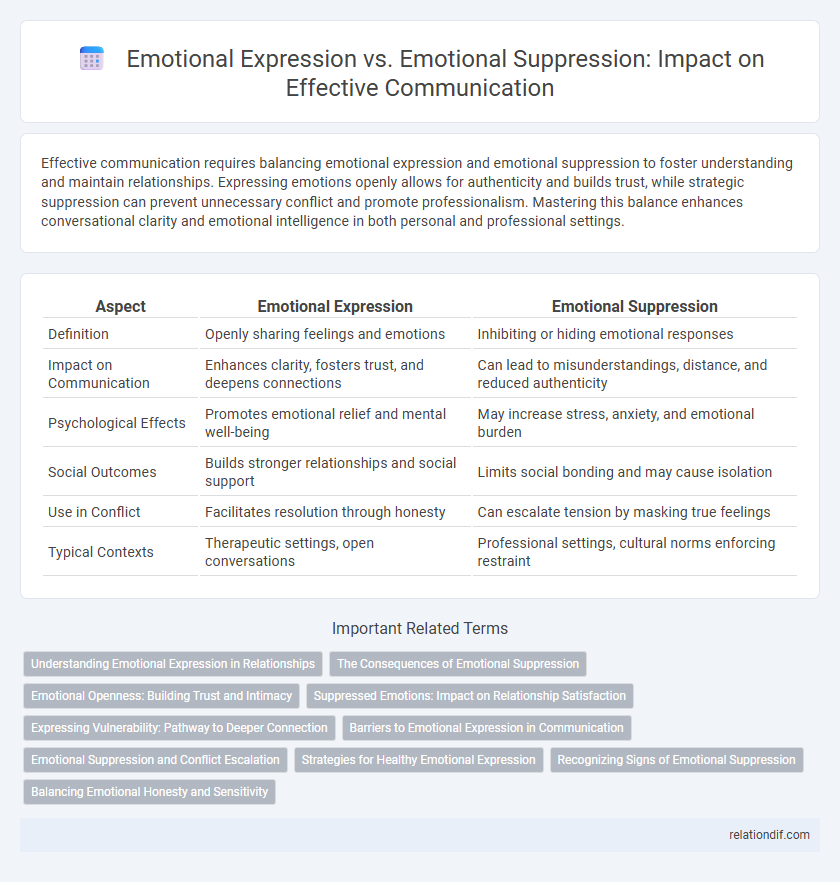Effective communication requires balancing emotional expression and emotional suppression to foster understanding and maintain relationships. Expressing emotions openly allows for authenticity and builds trust, while strategic suppression can prevent unnecessary conflict and promote professionalism. Mastering this balance enhances conversational clarity and emotional intelligence in both personal and professional settings.
Table of Comparison
| Aspect | Emotional Expression | Emotional Suppression |
|---|---|---|
| Definition | Openly sharing feelings and emotions | Inhibiting or hiding emotional responses |
| Impact on Communication | Enhances clarity, fosters trust, and deepens connections | Can lead to misunderstandings, distance, and reduced authenticity |
| Psychological Effects | Promotes emotional relief and mental well-being | May increase stress, anxiety, and emotional burden |
| Social Outcomes | Builds stronger relationships and social support | Limits social bonding and may cause isolation |
| Use in Conflict | Facilitates resolution through honesty | Can escalate tension by masking true feelings |
| Typical Contexts | Therapeutic settings, open conversations | Professional settings, cultural norms enforcing restraint |
Understanding Emotional Expression in Relationships
Emotional expression plays a crucial role in building trust and intimacy within relationships by allowing partners to share feelings openly and authentically. Suppressing emotions often leads to misunderstandings, increased stress, and emotional distance, undermining effective communication. Studies show that couples who regularly express emotions experience higher relationship satisfaction and improved conflict resolution.
The Consequences of Emotional Suppression
Emotional suppression often leads to increased psychological stress, decreased emotional well-being, and impaired interpersonal relationships due to the inability to process and communicate feelings effectively. Research shows that chronic emotional suppression can contribute to heightened risks of anxiety, depression, and cardiovascular problems, highlighting the importance of healthy emotional expression. In communication, openly expressing emotions fosters trust and empathy, whereas suppression creates barriers that hinder genuine connection and conflict resolution.
Emotional Openness: Building Trust and Intimacy
Emotional openness fosters trust and intimacy by encouraging honest sharing of feelings, which strengthens communication between individuals. Expressing emotions openly allows for deeper understanding and connection, reducing misunderstandings and emotional distance. In contrast, emotional suppression can create barriers that hinder authentic relationships and limit the development of mutual trust.
Suppressed Emotions: Impact on Relationship Satisfaction
Suppressed emotions often lead to decreased relationship satisfaction by fostering misunderstandings and emotional distance between partners. Research indicates that individuals who habitually hide their feelings experience lower intimacy and increased conflict, hindering effective communication. Long-term emotional suppression correlates with reduced trust and empathy, essential components for maintaining healthy, fulfilling relationships.
Expressing Vulnerability: Pathway to Deeper Connection
Expressing vulnerability in communication fosters authentic emotional expression, promoting trust and deeper connections between individuals. Emotional suppression often leads to misunderstandings and barriers, hindering meaningful interpersonal bonds. Prioritizing open emotional expression enhances empathy, strengthens relationships, and supports mental well-being.
Barriers to Emotional Expression in Communication
Barriers to emotional expression in communication often stem from fear of judgment, cultural norms, and lack of emotional vocabulary, which inhibit authentic connection and understanding. Emotional suppression can escalate stress and misunderstandings, reducing relationship satisfaction and impairing conflict resolution. Overcoming these barriers requires cultivating emotional awareness, empathy, and safe environments for open dialogue.
Emotional Suppression and Conflict Escalation
Emotional suppression during communication often leads to unresolved tensions, escalating conflicts by creating misunderstandings and resentment. When individuals withhold their true feelings, it impedes authentic dialogue and causes emotional buildup that intensifies disagreements. Research shows that suppressing emotions correlates with higher stress levels and reduced conflict resolution effectiveness, fostering a cycle of escalating disputes.
Strategies for Healthy Emotional Expression
Effective communication involves strategies for healthy emotional expression, such as using "I" statements to clearly convey feelings without assigning blame. Practicing mindfulness facilitates awareness of emotions before responding, helping to prevent emotional suppression and reduce stress. Creating a safe environment for open dialogue encourages vulnerability and strengthens interpersonal connections by fostering trust and empathy.
Recognizing Signs of Emotional Suppression
Recognizing signs of emotional suppression involves observing reduced facial expressions, limited verbal sharing, and avoidance of discussing feelings during communication. Individuals may exhibit tension, irritability, or withdrawal, signaling internalized emotions that hinder authentic connections. Awareness of these indicators enables more empathetic responses and encourages healthier emotional expression.
Balancing Emotional Honesty and Sensitivity
Balancing emotional honesty and sensitivity enhances communication by fostering trust while respecting others' feelings. Expressing emotions authentically encourages deeper connections, yet moderating intensity prevents misunderstandings or conflict. Effective communication requires recognizing when to share genuine feelings and when to exercise emotional restraint for relational harmony.
Emotional expression vs emotional suppression Infographic

 relationdif.com
relationdif.com